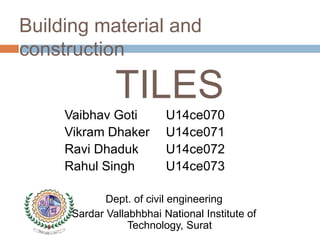
Tiles
- 1. Building material and construction TILES Vaibhav Goti Vikram Dhaker Ravi Dhaduk Rahul Singh Dept. of civil engineering Sardar Vallabhbhai National Institute of Technology, Surat U14ce070 U14ce071 U14ce072 U14ce073
- 2. CONTENT Introduction Why to choose Tiles?? How tiles are manufactured? Types of Tiles a. Based on material b. Based on Application Comparison btw Vitrified and Ceramic Tile Price range
- 3. Introduction A tile is a manufactured piece of hard-wearing material such as ceramic, stone, metal, or even glass, generally used for covering roofs, floors, walls, showers, or other objects such as tabletops. Tiles are most often made of ceramic, typically glazed for internal uses and unglazed for roofing. They can be range from simple square tiles to complex mosaics.
- 4. Why Choose Tiles?? Low maintenance: Tile can be easily cleaned, often only with warm water, reduce the need for chemicals and cleaners needed to maintain other types of floors. Water Resistance : Tiles are waterproof, making them a perfect choice for swimming pools, showers, patios, and other wet areas. Economic : They are nearly cheap as compare to other options.
- 5. It Comes in a Variety of Options: When it comes to finding the right tile flooring, you'll have a wide range of options in terms of color and style.
- 6. How tiles are manufactured?
- 7. Types of Tiles:Based on application There are many types of tiles used for residential and commercial applications. 1. Roof tiles 2. Floor tiles 3. Pebble tiles 4. Ceiling tiles 5. Wall tiles
- 8. Roofing Tiles: Roof tiles are designed mainly to keep out rain, and are traditionally made from locally available materials such as clay or slate. Roofing tiles
- 9. Flooring tiles: These are commonly made of ceramic or stone. Recent technological advances have resulted in rubber or glass tiles for floors as well.
- 10. Pebble tiles: Pebble Tiles is a composite material made up of marble pebbles or pieces of natural stone in different sizes, bound together with a transparent white or colored resin.
- 11. Ceiling tiles Ceiling tiles are type of tiles used for covering ceilings of rooms. Suspended ceilings Decorative Ceiling Tile
- 12. Wall Tiles: The concept behind using wall tiles is decorating the interior of a home without adding much stuff to the home.
- 13. Type of Tiles: Based on material used Tiles can be made from many materials but the most common of them are 1. Ceramic Tile 2. Vitrified Tile 3. Glass mosaic 4. Stoneware Tile 5. Terracotta Tile
- 14. Ceramic Tiles A ceramic is an inorganic, non-metallic solid material. Ceramic tile is made up of silica and clays and once it has been moulded into desired shape they are then fired in a kiln. When making ceramic tiles they can either be glazed or unglazed, but the majority of homeowners have glazed ceramic tiles in their home.
- 17. Vitrified Tiles Vitrified tiles are non-glazed tiles. Their hardness and polish is achieved by virtue of the pressing together of very hard materials. They are extremely strong and durable and manufactured in such a way that they absorb negligible amount of water. Vitrified tiles have a water absorption of < 0.1%. Can be available in natural designs
- 18. Vitrified Tiles giving same appearance as granites & marbles.
- 19. Types of Vitrified Tiles 1. Full body • Color and design is same throughout the tile • If a tile does chip, the color and design is same underneath making chip less noticeable
- 20. Type of Vitrified Tiles 2. Double Charge tile • Are variation of full body tiles. • Layer of design is not throughout but only on top 3mm to 4mm of the tile. • It has different face and body.
- 21. Glass Mosaic These are the tiles made from molten silica glassy content or by cutting larger glass slabs. Mosaic is the art of creating images with an assemblage of small pieces of colure glass, stone, or other materials.
- 22. Glass mosaic table top
- 23. Stoneware Tile These are the tiles which are essentially cut- to-shape products made by cutting & shaping from processed rocks, stones etc. Sandstones, slates, granites, marbles, etc. are a few examples. Porosity of such tiles depend largely upon the source rock.
- 24. Terracotta Tile Terracotta clay, a type of earthenware ,is a clay-based unglazed or glazed ceramic, where the fired body is porous. Terracotta is a brownish –red clay that has been baked and is used for making things such as tiles.
- 26. Advantage of Vitrified over ceramic Tiles Low in strength and impact resistance Catches stain due to porosity High water absorption upto 14% Non resistance to temperature changes High in strength and impact resistance Water absorption is less than 0.1% Resistance to temperature changes Ceramic Vitrified
- 28. Price Range per sq. feet 1. Vitrified tile: Rs 30 to 150 2. Ceramic tile: Rs 15 to 40 3. Glass mosaic: Rs 40 to 1500 4. Terracotta tile: Rs 15 to 20
- 29. Thank you